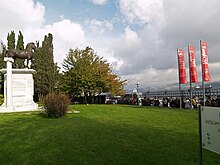Sakıp Sabancı Müzesi
The Sakıp Sabancı Müzesi (dt. Sakıp Sabancı Museum ) is a private art museum in Istanbul . It was founded by Sakıp Sabancı and opened in June 2002. The museum houses a collection of Islamic art and paintings from the Ottoman Empire .
location
The museum is set back from Sabancı Caddesi on the banks of the Bosphorus in a park in the Sarıyer district of Istanbul .
History of the building
The historical two-story building belonged to several high-ranking pashas and khedives from 1848 . In 1884 it was bought by the Ottoman treasury on the instructions of Sultan Abdülhamid II. The Sultan gave it to King Nikola I of Montenegro . For the next 30 years, Montenegro used it as a royal residence and embassy. In 1913 it was returned to the Ottoman state. It became the home of the granddaughter of Sultan Mehmed V. After the founding of the Republic of Turkey, the Egyptian prince Mehmed Ali Hasan, grandson of the Khedive Ismail Pasha , acquired the dilapidated house and commissioned the architect Edouard de Nari to rebuild it. Even so, the building remained uninhabited for many years until the prince's older sister moved in in 1944.
In 1951, Hacı Ömer Sabancı , father of Sakıp Sabancı and founder of Sabancı Holding , bought the house as a summer residence for his family. In the front yard he set up a bronze statue of a horse that he had bought at auction. Louis-Joseph Daumas created the sculpture in Paris in 1864. The house became known as Atlı Köşk ("Horse Villa"). Sabancı lived there with his family until his death in 1966. From 1969 to 1999, Sakıp Sabancı lived in the villa with his family.
In 1998 the building with the furniture and the art collection was leased to Sabancı Üniversitesi for 49 years . Today the house and a modern gallery extension house a collection of art from the 20th and 21st centuries.
collection
At the beginning of the 1940s, Hacı Ömer Sabancı mainly collected figurines, metalwork, porcelain , art objects and furniture. Sakıp Sabancı continuously expanded his father's collection from the 1970s. The collection includes Chinese porcelain from the 18th and 19th centuries, Famille noire and Famille verte ceramics, polychrome vases and decorative plates. The most valuable pieces include a collection of 19th century French porcelain, including some Sèvres vases and German porcelain from Berlin and Vienna .
The Calligraphy Collection contains more than 400 exhibits of Ottoman calligraphy art from more than 500 years, including Quran manuscripts and prayer books, calligraphic panels, decrees, documents, declarations, seals, books of poetry and calligraphic tools.
The collection also includes more than 320 paintings from the Ottoman and Republican era of Turkey, including works by Osman Hamdi Bey , İbrahim Çallı , Halil Pascha , Nazmi Ziya Güran , Şeker Ahmet Paşa , Fikret Mualla and by European artists such as Fausto Zonaro and Ivan Ayvazovsky who lived and worked in the Ottoman Empire.
Temporary exhibitions (selection)
In addition to the permanent exhibition with exhibits, the museum also organizes temporary exhibitions:
- 2003/04: Partnership of Power: Artifacts from the Istanbul Archaeological Museum , man and horse
- 2003/04: From the Medicis to the House of Savoy : Ottoman splendor in Florentine collections
- 2005/06: Picasso in Istanbul
- 2006: Rodin in Istanbul
- 2007/2008: The world of Abidin Dino
- 2008: Istanbul, Isfahan and Delhi : Three capitals of Islamic masterpieces in the Louvre collection
- 2008/09 Salvador Dalí : A Surrealist in Istanbul
- 2009: Joseph Beuys and his students: Works from the Deutsche Bank Collection
- 2010: Legendary Istanbul: From Byzantium to Istanbul, 8,000 years of the capital
- 2012: “Where darkness meets light ...” Rembrandt and his contemporaries: The golden age of Dutch art
- 2012: CoBrA - 1000 days of free art
- 2013: Anish Kapoor in Istanbul
- 2014: Joan Miró . Women, birds, stars
- 2015/16: ZERO . Countdown to the future
- 2017: Feyhaman Duran - Between Two Worlds
- 2017/18: Ai Weiwei - On Porcelain
Exhibitions outside the museum
The museum is regularly represented with exhibitions outside of Turkey. In 2008, masterpieces of Ottoman calligraphy were on view in the Alcázar in Seville . The exhibition “Lines in Gold: Ottoman Calligraphy from the Sakıp Sabancı Museum, Istanbul” also moved to the Real Academia de Bellas Artes de San Fernando in Madrid .
digitalSSM: Digital Art Archive
digitalSSM started in 2013 for the museum's 10th birthday. it is one of the company's most ambitious projects. The archive makes around 77,000 high-resolution images of the collection items available online. It was the first digitized collection of a museum in Turkey. The platform provides all information about the book and calligraphy collection, the painting collection, as well as the Abidin Dino archive and the Emirgan archive. All pictures of the exhibits are freely accessible and without license fees.
Gastronomy and events
In 2005, the Changa restaurant with the “Müzedechanga”, which has existed in Istanbul since 1999, moved into the museum. The glass restaurant was voted the best new restaurant by Wallpaper * in 2007 . The head chef is Pınar Taşdemir .
With “the Seed”, the house also has a small conference and event center. The 1,700 m² the Seed has a concert hall with 330 m² and a foyer with 600 m².
Web links
- Sakıp Sabancı Museum website (English)
- Digital collection
- The museum at ArchNet
Individual evidence
- ^ History , Sakıp Sabancı Museum, accessed April 6, 2018
- ^ Collection , Sakıp Sabancı Museum, accessed April 7, 2018
- ↑ Past exhibitions , Sakıp Sabancı Museum, accessed on April 7, 2018
- ↑ site of Müzedechanga, accessed on April 7, 2018
- ↑ the Seed , Sakıp Sabancı Museum, accessed April 7, 2018
Coordinates: 41 ° 6 ′ 21.9 ″ N , 29 ° 3 ′ 22.6 ″ E


